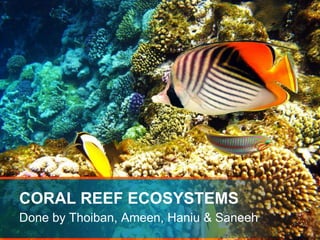
Explore Coral Reef Ecosystems
- 1. CORAL REEF ECOSYSTEMS Done by Thoiban, Ameen, Haniu & Saneeh
- 2. WHAT IS A CORAL? • Corals are composed of thin plates, or layers, of calcium carbonate secreted over time by hundreds of soft bodied animals called coral polyps. • Polyps range in size from a pinhead to a foot in length. • Each polyp lives in a symbiotic relationship with a host zooxanthellae that gives the coral its color
- 3. • Zooxanthellae take in carbon dioxide, process it through photosynthesis, and give off oxygen and other important nutrients that are then used by the host polyp. • As in all photosynthesizing organisms, this means that corals must be exposed to a sufficient amount of sunlight. This confines most corals to shallow waters that are clean and clear.
- 4. • There are two kinds of corals: hard and soft. Hard corals (Scleractinia), such as brain, star, staghorn, elkhorn and pillar corals have rigid exoskeletons, or corallites, that protect their soft delicate bodies. • Soft corals (Gorgonians), such as sea fans, sea whips, and sea rods, sway with the currents and lack an exoskeleton.
- 5. WHAT IS A CORAL REEF? • Coral reefs are one of the most biologically diverse ecosystems on earth, rivaled only by tropical rain forests. • They are made up not only of hard and soft corals, but also sponges, crustaceans, mollusks, fish, sea turtles, sharks, dolphins and much more.
- 6. • Competition for resources such as food, space and sunlight are some of the primary factors in determining the abundances and diversity of organisms on a reef. • Each component of a coral reef is dependent upon and interconnected with countless other plants, animals and organisms.
- 7. • This means that fluctuations in the abundance of one species can drastically alter both the diversity and abundances of others. • While natural causes such as hurricanes and other large storm events can be the stimulus for such alterations, it is more commonly anthropological forces that effect these types of shifts in the ecosystem.
- 8. • For example, overfishing of herbivorous fish often results in increased growth of algae and sea grasses. This generally results in an increase in other herbivorous marine life, such as sea urchins. • Over time all ecosystems will naturally establish these types of balances between predators and prey and organisms in competition for similar resources.
- 9. WHAT IS A CORAL REEF ECOSYSTEM? • The coral reef ecosystem is a diverse collection of species that interact with each other and the physical environment. • The sun is the initial source of energy for this ecosystem. • Through photosynthesis, phytoplankton, algae, and other plants convert light energy into chemical energy. A portion of this energy is passed on as animals eat plants or
- 10. CORAL REEF ANIMALS • Coral reefs provide habitats for a large variety of plants and animals. These plants and animals rely on corals as a source of food and shelter. Sponges are found inhabiting holes in the reef. They remove small chips from the coral. These sponges, such as Cliona, cause deterioration in corals.
- 11. • Sponges inhabit corals for the purpose of protection from predators. Sea worms depend on corals for food. They feed on corals such as Porites and Agaricia. • Shrimps and crabs depend on corals for shelter. Xantid crabs form hole in some types of coral. • Fish also depend on corals for protection against predators. One such is the parrot fish.
- 12. • Sea stars are coral predators. This crown- of-thorns starfish relies on corals for food. • There are many other species of fungi, sponges, sea worms, crustaceans and mollusks that bore into coral skeletons. • Other organisms that inhabit the coral reefs include sea urchins, jellyfish, oysters, clams, turtles, an d sea anemones.
